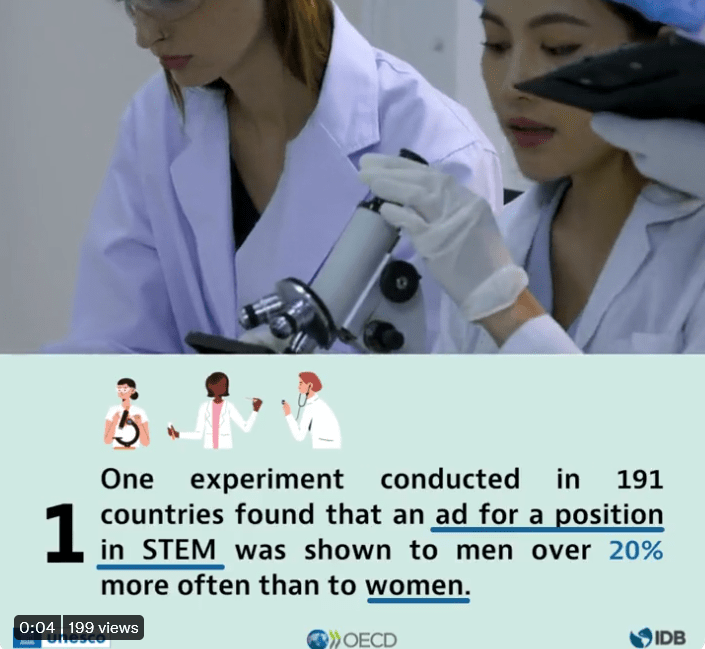Why We Need More Women in STEM in the Western Balkans?

Why do we need more women in STEM fields in the Western Balkans? Simple.
The demand for STEM (Science, Technology, Engineering and Mathematics) experts and professionals will grow in the future. We need to ensure equal access to all stages of the workforce lifecycle. This includes job requirements, hiring to career progression and upskilling within the workplace.
Despite that women’s involvement in STEM studies and careers remains low in the Western Balkans.
Where do women in STEM stand globally?
 According to the World Economic Forum's annual Global Gender Gap Report 2021, women's estimated earned income is just 72.1% of men’s.
According to the World Economic Forum's annual Global Gender Gap Report 2021, women's estimated earned income is just 72.1% of men’s.
Only 12.4% of women graduates prefer STEM disciplines, as opposed to 49.8% of men graduates.
Women represent only 29% of science and R&D positions globally.
Globally, more women than men enrol in higher education but men on average attain STEM degrees four times more frequently than women.
Overall, women's attainment rates in STEM disciplines are only 14.1%.
The entire world is lagging behind Finland that already closed so-called Educational Attainment gender gaps at all levels of education.
Their focus now is on encouraging women to study disciplines traditionally dominated by men, as the report highlights.
Women in STEM in the Western Balkans
The RCC's study has shown that 56% of enrolled students in tertiary education were female over the period 2015-18 in the region.
This proportion remains high in some STEM subjects, where the WB6 economies outperform the EU average. North Macedonia outperforms all Western Balkan economies with a difference of 21 percentage points compared to the EU average (2018).
North Macedonia and Serbia have higher shares of female students in natural sciences, mathematics, and statistics subjects than the EU.
Similarly, the Global Gender Gap Report 2021 shows that STEM attainment in Albania was 15.20% among women compared to 30.01% for men. Bosnia and Herzegovina performed somewhat better with 16.12% attainment for women and 28.43% for men.
North Macedonia and Serbia fare slightly better. In North Macedonia, these figures were 18.01% among women population compared to 27.16% among men. Serbia's performance is better among both demographics: 20.32% among men and 39.32%. Still, men outnumber women by almost a double margin.
Why do men outnumber women in STEM?
 There are many reasons. The key reason explaining such a gap in STEM fields could be gender stereotypes.
There are many reasons. The key reason explaining such a gap in STEM fields could be gender stereotypes.
One of RCC's studies has shown that many still perceive STEM as a masculine field incompatible with the women’s home responsibilities.
Deeply rooted prevailing social norms and attitudes lower the female incidence in STEM fields of study and related jobs.
Under the pressure of dominant social norms and values, girls tend to make educational and career choices.
Also, women enrol less in STEM education and stay less in the STEM labour market partly due to gender discrimination.
In recent years, only a few government-supported measures specifically targeted women’s participation in STEM. None of the region's economies has created systematic and tailor-made policies for women in STEM.
However, another study shows an important finding. On average, the higher the educational level attained, the lower the female disadvantage in the labour market.
This is exactly why the region's governments should invest additional efforts into encouraging girls to enrol in tertiary education.
The same goes for STEM fields. The more women in STEM education, the easier it will be for them to find jobs.
More importantly, a higher rate of women in STEM education and jobs will naturally lead to a more balanced business culture in these fields.
What can we do to attract more women to STEM?
Changing the systemic approach is the key.

Women face more obstacles related to prejudices, social norms and expectations when choosing their area of study or career path than men.
Hence our education policymakers should consider changing the curricula and syllabuses to cater to the needs of girls and young women.
Attracting more young women into STEM study fields and male-dominated occupations is critically important for the region's economic development.
Specifically, we should find creative ways to promote STEM education for women and women in STEM education. Programs for vocational guidance and orientation should be developed and implemented from an early age.
We need mentorship and internship programmes that empower girls and young women. These role models will be able to speak for themselves in their immediate environments.
If promoted through social media such examples can reach many female young individuals around the region. We should always have in mind that good news travels fast.
But that isn't all.
More often than not, the promotion of STEM in the region equals the promotion of the ICT sector. We need an overarching approach that will include other subfields in math, science, technology and engineering.
Awareness campaigns should target the business and human resource management in companies in the STEM sectors to address the prevailing glass ceiling for women in management positions.
Finally, policymakers should introduce tailor-made responses to cater to the needs of women in STEM fields. Gender mainstreaming requires a targeted approach and continuous monitoring and evaluation of existing policy instruments from a gender perspective.
Let's be honest, this is easier said than done. However, we better start sooner rather than later.
